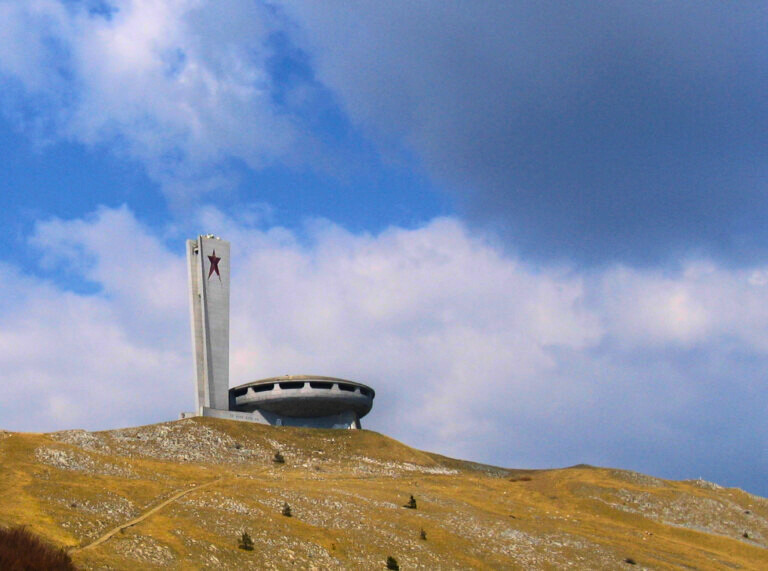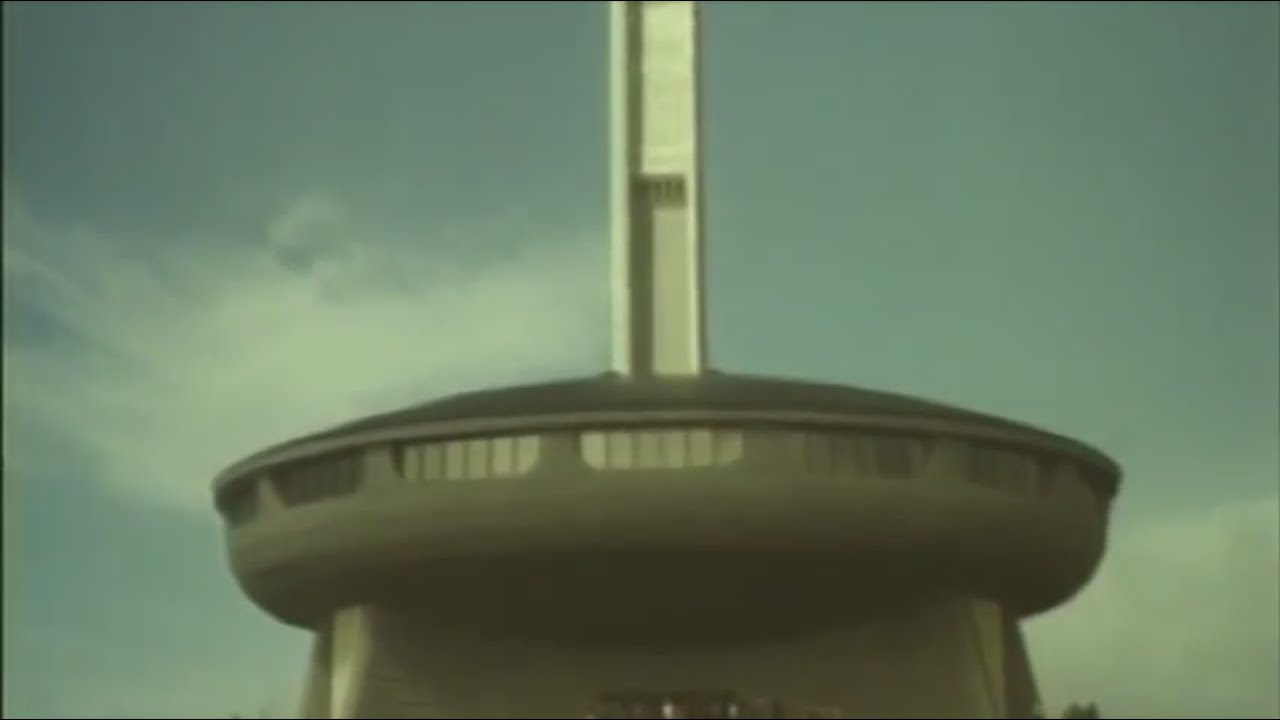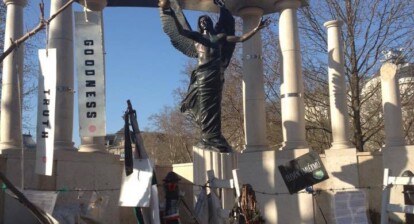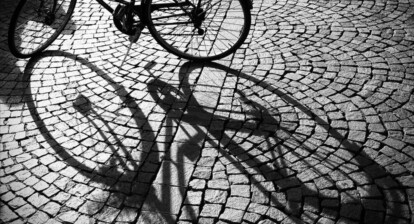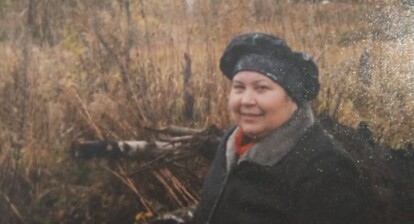The Seven Wonders of the Ancient World are probably somehow familiar to you. What about the Seven most endangered cultural sites in Europe? One of them is Buzludzha: The name of a peak in the Central Balkan Mountains, which is home to an iconic brutalist monument, an object of controversy since its construction began in 1971. What do young people in Bulgaria think about the abandoned “UFO” and its future? Our editor Liliana found out.
First Encounters With Buzludzha
I do not remember the first time I found out about Buzludzha’s existence, but it must have been during Literature or History class in school. I have not visited the monument, as it is located 253 km away from Bulgaria’s capital Sofia, on top of a 1441-meter-high peak named Hadji Dimitar, also known as the Buzludzha peak. It is safe to say that unless you are headed specifically there, there is no chance that you will end up on the top of the mountain by chance. What recently inspired me to further research was the fact that one of my work colleagues used to volunteer at Buzludzha Project Foundation. Its goal: to preserve the building as an outstanding example for thousands of other forgotten monuments and sites.
The Story Behind “The Monument House of The Communist Government”
After the end of the regime, it was abandoned for obvious reasons – it symbolised and reminded of a period that morally and emotionally crippled an entire nation for generations to come. That is the main argument of one of the two sides in the heated public debate about the future of the monument.
Thanks to the efforts of the aforementioned foundation, 2023 will be the first time in decades that visitors will be able to legally enter the monument. It may seem as if the future of the Bulgarian UFO has already been decided. However, the controversy around it will persist for years to come. The reason is that although locals are unlikely to take more active measures such as forming a movement, they will protest silently by simply disapproving. I turned to two Bulgarians who live abroad – my friend Kalina, based in Eindhoven, the Netherlands, and EUSTORY History Campus’ editor Decho, who studies in Vienna, Austria. I wanted to hear their opinions on the monument shortly before its official re-opening.
What to do With Markers of a Painful Past?

Buzludzha inside before its reconstruction. Photo: Mark Ahsmann, Wikimedia Commons (Creative Commons Attribution-Share Alike 4.0 International)
Decho: Whether we like it or not, socialism was part of Bulgaria’s history, so the next generations must know about this dark moment from as many angles as possible.
Kalina: What does painful past mean? Nowadays we are very fond of labeling people, events, eras, ideologies as good or bad. Christopher Columbus is an example – for some, he is a man with great ideas for his time and the discoverer of America. For others, he is the coloniser whose actions led to the genocide of the indigenous population. As a result, monuments in his honor have been removed in San Francisco and Mexico City, there has also been a campaign to do so in Barcelona.
I grew up being told that democracy (officially established in 1990 in Bulgaria) was good because back in the communist days, there used to be no opportunity to go abroad, no freedom of speech, no right to make fun of the government, no bananas, mandarins or oranges except for one day in the year – around New Year’s eve. That’s how my view that this ideology is bad and shuts people down was formed.
Re-thinking the Narrative: A Young Adult’s View of Communist Bulgaria
Growing up, I started questioning my negative view on Bulgaria’s former political system. Most elderly people think that it was better back in the communist times, as there was employment for “everyone”.
From the point of view of those living then, there were enough resources and the majority of people belonged to the so-called middle class. Nowadays, the middle class melts away and the gap between the richest and the poorest is widening. Back in the days, you would work in a factory for your entire life, and have the certainty that you would provide for your family. The fact that this is not how things work anymore makes me think about the other side of the coin and conclude that communism is neither entirely bad, nor entirely good.
Should we Preserve Monuments at All Costs?
In Praise and in Question: The Dual Role of Historical Monuments
Kalina: The purpose of many monuments is to praise and express gratitude to someone or something that contributed to society. Many of the monuments were erected in times when the idea or person was praised and later rejected. During World War II, there were monuments in honor of Hitler, Stalin, Mussolini, which were subsequently removed. Evaluating ideologies is even more complex than evaluating people.
The other purpose of the monuments is informative. Knowing history should not be reduced to reading dry books and articles. Observing a monument leads to wondering why someone’s face is on the facade, who this person is, what they did. This quality of monuments cannot be replaced in any other way.
Learning From the Past Through Dialogue
If there is a monument that seriously hurts society, it may be wise to demolish it. An alternative is for the monument to remain with a descriptive plaque alongside, which summarises both the positive and the negative aspects of the historical events pertaining to it. However, it is better to have different opinions and debates than not having them at all. Discussions bring to the fore arguments and knowledge from which we can learn in order to not repeat the same mistakes. As far as the good moments are concerned – let’s try to repeat them.
The Fine Line Between Preserving the Past and Embracing the Future
In addition to Buzluzhda, I can think of other smaller-scale similar monuments belonging to the same historical period such as the Sofia Red Army Monument. Another example is the hard-to-surrender mausoleum of the founder of the Bulgarian Communist Party Georgi Dimitrov, the demolishment of which took seven days and four attempts. What they both symbolise is part of our history. By removing the monuments, we are not erasing the past – it will always be there. Even if you try to demolish the proof of the painful past, but that doesn’t mean it hasn’t happened. However, if there is no monument to see, the only way to find out about it is to take initiative and open a book. The presence of a monument will make you unclog your brain, even if that means causing conflicting opinions.
Buzludzha: Mirror of a Generational Ideological Clash?

Close shot of the monument. Photo: 2427999, Pixabay (Pixabay license)
Kalina: Perhaps yes. What matters is who lived for how long under communism. The ones who are 60 years old have spent half of their life shaped by communism and half of it living in democratic conditions. They are the most likely to have an objective assessment in the debate. The ones over 60 have lived most of their life under communism and that’s what they are used to, that’s their comfort zone.
Living in the Netherlands, the freedom to travel seamlessly to Belgium without any border checks has become the norm for me. The thought of being confined to one country and being forced to work for the same company for my entire life is a scary and foreign concept. Once you’ve experienced freedom, it’s hard to envision life without it – it’s become my comfort zone and familiar way of living.
For or Against Buzluzhda’s Ongoing Restauration?

Buzludzha before its restauration used to be in a state of dereliction. Photo: Michael Kötter, Flickr (CC BY-NC-SA 2.0)
Kalina: It is saddening to see Buzluzhda in a pitable condition, only because the majority of people associate the monument with an ideology that is no longer on the agenda, or they focus on the negatives of it. Likewise, we have monuments of kings before whose victorious battles we bow. But these same wars have been destructive and losing for another nation.
I support the idea of Buzluzhda being revived. It glorifies a certain era, a particular party and an ideology that has taken thousands of lives. There are people in my family who “disappeared” during the regime. However, the monument was built with a good intention, namely to be a ceremonial venue and a memorial, for people to gather there and celebrate. It wasn’t built with the idea of it collapsing and being the reason for accidents happening to people trying to get into it despite the warnings.
In addition, Buzluzhda is not just a statue, but rather an extremely towering monument, the construction of which took seven years and more than 6,000 people. Let’s think about the enormous work that has been done, and not in the center of a city, but on top of a mountain. About the effort to get there and to organise the transportation of the construction elements. Dooming this monument to ruin is disrespectful to all these efforts.
How Should The Monument’s Future Look Like?
Kalina: Buzluzhda is a large-scale and suitable facility for a museum, as it has a large attendance and could generate tourism revenue. The museum should be conceptualised with the idea to represent a “door to history” and be a valuable historical resource. It should inform about both the good and the bad sides of the regime. In this way, all the viewpoints of the ideology will be gathered in one place, including the ones of people who participated in the construction of the monument, the opponents of its construction and the victims of the regime.
Decho: The monument is already there, so if it was up to me, I would renovate it and then tell my children what this monument is about. For me, most importantly, is to teach the children of the past, so that they can make some conclusions of their own.
Why Are Many Bulgarians Against The Restoration of The Monument?
Decho: It really has to do with the fact that many Bulgarians (especially these who lived during the time) associate the monument with lack of personal freedom and repressions. And Buzludzha was (and still, kind of, is) the meeting point of huge manifests, so I can understand this bias. Concerning other monuments, I once saw some footage from blowing Georgi Dimitrov’s mausoleum. It should have been a very big event – during the 90’s people in Bulgaria screamed democracy and wanted to gey rid off the person that took this away from them…
How do Other Countries Deal With Controversial Monuments?
The Dutch case of “Black Pete”
The Dutch case of “Black Pete”
Kalina: In the early months of 2020, a wave of vandalism saw dozens of statues of historical figures in Belgium and the Netherlands, linked to colonialism and slavery, being taken down. The events coincided with the time when Americans were reconciling their past and the present. For instance, protesters dumped paint on a statue of Leopold II in Antwerp, Belgium, and then set it afire. They also called for the removal of a statue of 17th century colonial-era Dutch officer Jan Pieterszoon Coen in Hoorn, the Netherlands. If you strongly disapprove of the monument, there is a more civilised way of fighting to have it removed.
Today, another debate is on the Dutch agenda. According to a Dutch tradition, during late November Sinterklaas (St. Nicolas) comes from Spain to the Netherlands by boat, taking the bad kids with him to Spain. Sinterklaas has a “helper” named Zwarte Piet, or “Black Pete,” who is a blackface character. The legend originated as the Dutch occupied African countries for years.
The question is, how do we explain to the children that colonialism is the reason for Black Pete’s skin color without introducing them to uncomfortable topics. Consequently, new narratives were introduced – that Black Pete enters houses through the chimney and therefore his face is smeared with soot.
To me, changing the narrative is obfuscation of the history with the intention to prettify the truth, namely that Dutch used to be colonisers. The tradition of Sinterklaas represents an opportunity to speak about history with children and discuss what their ancestors were like, what a colony means, what was happening in the colonies, and talk about slavery and the injustices of life. Whether we are proud of these moments or not, they are our legacy and have shaped us into who we are today.
Picture: Michell Zappa, Wikimedia Commons (Creative Commons Attribution-Share Alike 2.0)
Austria's Heroes' Monument of the Red Army
Austria's Heroes' Monument of the Red Army
Decho: There is the Heroes’ Monument of the Red Army that is close to the Belvedere Castle. It is way bigger than the Soviet Army Monument in Sofia and it actually praises the Soviet soldiers that freed Vienna from the fascists after the Second World War. However, because of the events of current political situation (Russia-Ukraine war), this monument has acquired a different meaning and not a good one…
Photo: Vmenkov, Wikimedia Commons (Creative Commons Attribution-Share Alike 4.0 International, 3.0 Unported, 2.5 Generic, 2.0 Generic and 1.0 Generic)
A Future For Buzludzha?
The once futuristic monument will be accessible to visitors starting from spring 2023. Nevertheless, opinions on the monument remain as polarised as one can imagine. It is “a masterpiece of architectural engineering”, “the most successful export of Bulgarian architecture in general”, “ an integral part of Bulgarian history”, “the most famous Bulgarian building in the world” for some. But it is a “symbol of “forever victorious communism in Bulgaria”, “a symbol of the victory of dictatorship over freedom”, “a monument to criminals, not their victims”, “ideological sign of the criminal communist regime” or “a monument to a criminal totalitarian dictatorship” for others.
There is always the middle ground, albeit rare – to describe it as a “monumental, saucer-like building” and call it a day.

